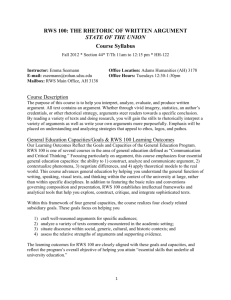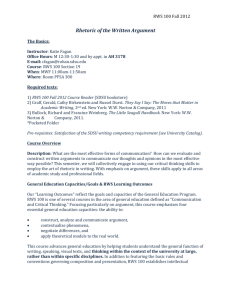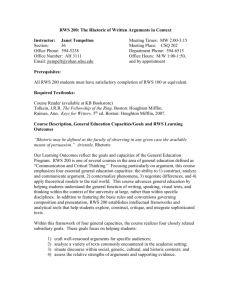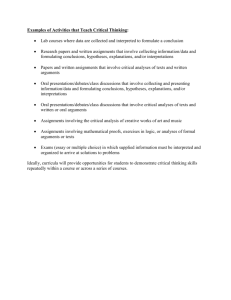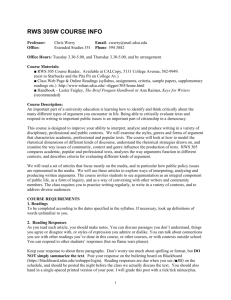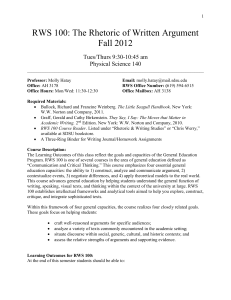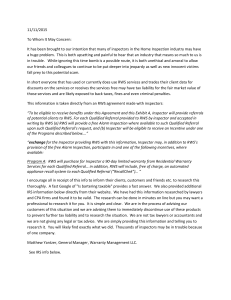Rhetoric and Writing Studies (RWS) 100
advertisement
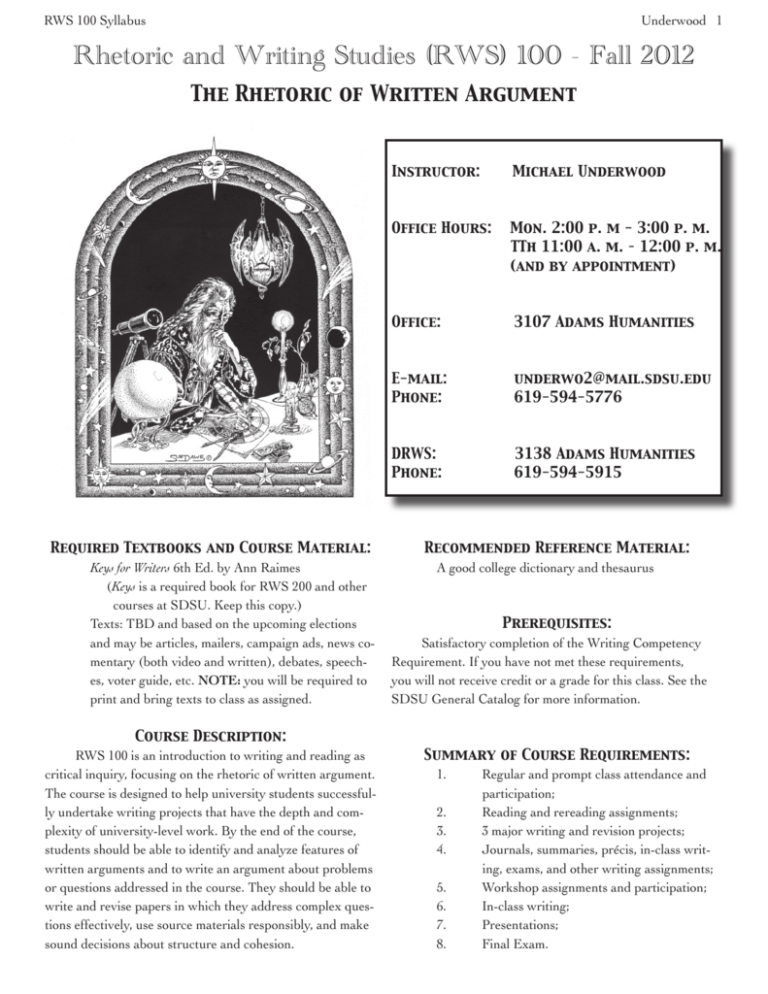
RWS 100 Syllabus Underwood 1 Rhetoric and Writing Studies (RWS) 100 - Fall 2012 The Rhetoric of Written Argument Required Textbooks and Course Material: Keys for Writers 6th Ed. by Ann Raimes (Keys is a required book for RWS 200 and other courses at SDSU. Keep this copy.) Texts: TBD and based on the upcoming elections and may be articles, mailers, campaign ads, news comentary (both video and written), debates, speeches, voter guide, etc. NOTE: you will be required to print and bring texts to class as assigned. Course Description: RWS 100 is an introduction to writing and reading as critical inquiry, focusing on the rhetoric of written argument. The course is designed to help university students successfully undertake writing projects that have the depth and complexity of university-level work. By the end of the course, students should be able to identify and analyze features of written arguments and to write an argument about problems or questions addressed in the course. They should be able to write and revise papers in which they address complex questions effectively, use source materials responsibly, and make sound decisions about structure and cohesion. Instructor: Michael Underwood Office Hours: Mon. 2:00 p. m - 3:00 p. m. TTh 11:00 a. m. – 12:00 p. m. (and by appointment) Office: 3107 Adams Humanities E-mail: Phone: underwo2@mail.sdsu.edu 619-594-5776 DRWS: Phone: 3138 Adams Humanities 619-594-5915 Recommended Reference Material: A good college dictionary and thesaurus Prerequisites: Satisfactory completion of the Writing Competency Requirement. If you have not met these requirements, you will not receive credit or a grade for this class. See the SDSU General Catalog for more information. Summary of Course Requirements: 1. Regular and prompt class attendance and participation; 2. Reading and rereading assignments; 3. 3 major writing and revision projects; 4. Journals, summaries, précis, in-class writing, exams, and other writing assignments; 5. Workshop assignments and participation; 6. In-class writing; 7.Presentations; 8. Final Exam. RWS 100 Syllabus Underwood 2 Participation and Classroom Etiquette: Showing up to class is essential, but attendance does not make up the bulk of participation; it is merely a prerequisite of participation. Reading the required materials is also a prerequisite for participation. If you do not know what a text is about, you will have a hard time saying something intelligent about it. Although we all have different comfort levels with talking, I expect everyone to interact with class discussions, group activities, etc. This class is an open forum and a place to exchange ideas and questions without fear. If you do not ask questions, I cannot answer them. If you do not discuss what you think assignments and readings are about, I cannot gauge where we need more work. We will be dealing with sensitive topics of all sorts. I encourage everyone to express themselves freely; this is not a place for censorship, but I do expect this to be done respectfully. Be aware of your audience and under no circumstances use hateful language. Similarly, as an audience, recognize we all come from different social locations and many opinions will not coincide with yours. If you find yourself offended do not hesitate to discuss the matter with me. “We read so that we know we’re not alone” (C. S. Lewis). Detailed Course Policies and Other Matters: Attendance: You are allowed two absence without penalty. I do not care what you do with this absence. I recommend you save it for an emergency such as an illness. However, if you choose to use them to spend a day at the beach or pick up your boy/girlfriend from the airport, that is your choice. Students who are more than 5 minutes late for class will be counted as absent unless they have informed the instructor beforehand of the reason for their lateness. Students who leave class early without having informed the instructor of a reason will be counted as absent. Every absence after the first will drop your participation by 5%. This is only a fifteen week course that meets twice a week, and it is imperative you are at each class. Late Work: Papers and writing projects turned in after they are collected in class are late and will be docked 5%. An additional 10% will be taken off the paper grade for each day after the first that the assignment is late. Homework and in-class work will not be accepted late. It is your responsibility to get the assignments turned in on time. Do not send any assignments as attachments to e-mail: they will not be accepted. Office Hours: I encourage you to visit me during my office hours (or by appointment), particularly, if you are having any trouble with the work in this course. Remember: when in doubt or troubled, always talk to instructors! Voice Mail: When leaving a message please make sure that you speak slowly, clearly, and leave your name and phone number. Voice mail will be checked on days that I am on campus. Written messages may be left in my mailbox, AH 3138. Assignments: Every assignment (besides in-class activities) must be typed, MLA formatted, 12 point Times New Roman font, double-spaced, one inch margins. The pages must be STAPLED, numbered, and include a header with your last name. I do not accept papers submitted online. Writing Assignments must follow the format, grammar, and punctuation guidelines as explained in Keys for Writers. Most writing assignments will use the MLA format and look like the sample in Keys section 13. Always title your assignments and center the title. Your last name and page number in the upper right corner can be added automatically by using the header feature in most word processing applications. When using quotations and the ideas of others refer to Part 3 “MLA Documentation” in Keys for Writers. Failure to follow instructions and assignment guidelines will lower your assignments grade. Special Arrangements: If you are registered with Disable Students Services and require special arrangements to be made in order to accommodate your learning needs, please let me know of your situation so that we can work together to ensure you have the opportunity to your best work. RWS 100 Syllabus Technology Policy: Make sure your phone is on SILENT, not on vibrate, but on SILENT. If your phone doesn’t have a silent setting, turn it OFF. Do not engage in textual activity in my class. Do not use iPods or any other musical devices in class. This includes have only one earphone in. Laptops are not allowed. I realize some students like to use laptops to take notes, but unless you personally convince me that this is absolutely necessary, you will have to use pen and paper. Underwood 3 “Better reading and writing leads to better thinking. Better thinking leads to better human beings.” Please read and take seriously E-mail guidelines: It is certainly appropriate to contact this instructor through e-mail about serious and emergency situations, important issues regarding the course, or a question that can be addressed with a quick, short response. Do not use to let your instructor know that you are going to be absent that day in class for whatever reason (see attendance), ask a question for which you can find the information or that requires a time-consuming lengthy response, ask what we did in class that day (get that information from another student, or call or visit the instructor during office hours), ask your instructor to review or provide feedback on writing assignments using e-mail (I will be happy to go over any of your work in person during office hours and by appointment), or send any assignment as an attachment. Assignments sent as attachments won’t be accepted and will be considered late.” Also, I do not always check or respond to e-mail several times a day or every day. Plagiarism: According to the policy file, “Plagiarism shall be defined as the act of incorporating ideas, words, or specific substance of another, whether purchased, borrowed, or otherwise obtained, and submitting same to the University as one’s own work to fulfill academic requirements without giving credit to the appropriate source. Plagiarism shall include but not be limited to (a) submitting work, either in part or in whole, completed by another; (b) omitting footnotes for ideas, statements, facts, or conclusions that belong to another; (c) omitting quotation marks when quoting directly from another, whether it be a paragraph, sentence, or part thereof; (d) close and lengthy paraphrasing of the writings of another; (e) submitting another person’s artistic works, such as musical compositions, photographs, paintings, drawings, or sculptures; and (f) submitting as one’s own work papers purchased from research companies.” Refer to page 432 of the General Catalog for the potential consequences of plagiarism which will result in an “F” on the assignment may include failing the course and/or possible expulsion from the university. I reserve the right to ask people to leave my classroom if necessary and there are a few surefire ways to accomplish this. One way is ignoring the technology policy. Everyone has pet peeves and cell phones are mine. Secondly, talking while others are talking or any other distracting/rude behavior will not be tolerated. This class aims to be a learning environment. If you choose not to learn, I will not stand in your way, but if you prevent anyone else from learning (including myself) I will ask you to leave. Academic Probation and Final Grades If you are on Academic Probation, it is not because of this course, It is becasue of low grades in other courses, and you to get yourself off of probation by raising those grades. Do not decieve yourself that a writing course is an easy way to raise your GPA: it is not. Grades will not be changed just because you face dismissal from the university. Please do not ask for a higher grade or special consideration at the end of the semester. RWS 100 Student Learning Outcomes Our Learning Outcomes Reflect the Goals and Capacities of the General Education Program. RWS 100 is one of several courses in the area of general education defined as “Communication and Critical Thinking.” Focusing particularly on argument, this course emphasizes four essential general education capacities: the ability to 1) construct, analyze and communicate argument, 2) contextualize phenomena, 3) negotiate differences, and 4) apply theoretical models to the real world. RWS 100 Syllabus This course advances general education by helping students understand the general function of writing, speaking, visual texts, and thinking within the context of the university at large, rather than within specific disciplines. In addition to featuring the basic rules and conventions governing composition and presentation, RWS 100 establishes intellectual frameworks and analytical tools that help students explore, construct, critique, and integrate sophisticated texts. Within this framework of four general capacities, the course realizes four closely related subsidiary goals. These goals focus on helping students 1) craft well-reasoned arguments for specific audiences; 2) analyze a variety of texts commonly encountered in the academic setting; 3) situate discourse within social, generic, cultural, and historic contexts; and 4) assess the relative strengths of arguments and supporting evidence. Our student learning outcomes for RWS 100 are closely aligned with these goals and capacities, and reflect the program’s overall objective of helping students attain “essential skills that underlie all university education.” Assignment Types: the following four outcomes describe the four of the 3 main writing projects or “assignment types” for the course. Students will be able to: 1. describe and analyze an author’s argument, claims, project, support and rhetorical strategies. 2. construct an account of an author’s project and argument and carry out small, focused research tasks to find information that helps clarify, illustrate, extend or complicate that argument; use appropriate reference materials, including a dictionary, in order to clarify their understanding of an argument; 3. construct an account of two or more authors’ projects and arguments and explain rhetorical strategies that these authors—and by extension other writers—use to engage readers in thinking about their arguments; 4. construct an account of two authors’ projects and arguments in order to use concepts from one argument as a framework for understanding and writing about another. Outcomes across the semester: the following points describe outcomes to work on throughout the semester, to be attained over the 15 weeks (5 weeks during the summer session. Students will be able to: Underwood 4 5. describe elements of an argument--claims, methods of development, kinds of evidence, persuasive appeals; annotate the work that is done by each section of a written argument; 6. use all aspects of the writing process--including prewriting, drafting, revising, editing, and proofreading; 7. choose effective structures for their writing, acknowledging that different purposes, contexts and audiences call for different structures; understand the relationship 9. effectively select material from written arguments, contextualize it, and comment on it in their writing; between a text’s ideas and its structure; 8. identify devices an author has used to create cohesion or to carry the reader through the text; use metadiscourse to signal the project of a paper, and guide a reader from one idea to the next in their writing; 10. determine when and where a source was published, who wrote it and whether it was reprinted or edited; understand that texts are written in and respond to particular contexts, communities or cultures; examine the vocabulary choices a writer makes and how they are related to context, community or culture, audience or purpose; 11. respond in writing to ideas drawn from various cultures and disciplines, using the activity of writing to clarify and improve their understanding of an argument; 12. analyze and assess the relative strengths of arguments and supporting evidence; 13. analyze and assess arguments made by visual texts; incorporate visual images into their documents; 14. craft well reasoned arguments for specific audiences; 15. edit their writing for the grammar and usage conventions ropriate to each writing situation; 16. assign significance to the arguments that they read; 17. reflect on how they wrote their papers, and revise arguments and findings based on critical reflection. RWS 100 Syllabus General Grading Criteria: The grading in this course is evaluative. If you have questions about your grade, read the assignment criteria, my comments, and the following criteria, and if you have further questions about your grade, schedule an out of class meeting for further discussion. An individual’s grades will not be discussed before or during class. Writing assignments are graded on focus, development, assignment parameters, flow, and mechanics. See below for the detailed criteria: A. Outstanding writing. Your paper contains a well-developed, critical, and specific thesis. The paper itself jolts the reader, per- suades, and holds interest without losing one in un- important and extraneous distractions that have nothing to do with proving the thesis. The flow of the essay is smooth, coherent, and concise. Your paragraphs are well-developed, unified, and transition well from the previous paragraph. (The stan- dard convention is that each paragraph begins with a topic sentence that contains a mini-thesis for that paragraph.). Your essay exhibits sentence variety and maturity. There are only insignificant mechani- cal errors, if any. Documentation is error free and follows assigned specifications. Underwood 5 any nonessential and extraneous information. Docu- mentation is inaccurate and does not follow assigned specifications. Summarizes instead of analysis. D. Poor writing. Your paper has a severely under- developed thesis or no apparent thesis at all. There are numerous errors in mechanics, logic, sentence structure, and/or organization. Your argu- ment and ideas are not successfully communicated. The writing interferes with your message in such a way that the essay is confusing and unintelligible. Documentation is inaccurate and does not follow specifications. F. Failing papers will be discussed on an individual basis. Letter grades correspond to the following percentages as per SDSU’s Policy A+ = 98-100% } A = 94-97% } Outstanding Achievement A- = 90-93% } B+ = 87-89% } B = 84-86% } Praiseworthy performance B- = 80-83% } C+ = 77-79% } C = 74-76% } Satisfactory performance; the C- = 70-73% } most common undergraduate grade B. Good writing. D+ = 67-69% } . Your paper contains a well-developed, critical, and D = 64-66% } Minimally passing specific thesis. The flow of the essay is smooth, coherent, and concise. Fluent, clear, logical, mature D- = 60-63% } = Under 60% - Failing vocabulary. Your essay exhibits sentence variety and F maturity. The writing enhances the message, which Course Grading policy means that the manner in which you convey your Homework: up to 100 pts. Project 1: 100 pts. message actually helps you to assert your argument. Peer Reviews: 30 pts Project 2: 120 pts. No major mechanical errors. Documentation is basi- Participation: 100 pts. Project 3: 150 pts. cally error free and follows assigned specifications. Final grades are determined by adding the points earned and dividing those by the total points for the course. C. Satisfactory writing. Your paper has an under-developed thesis. The writing will convey your meaning, however it is not crystal clear. The paper is not sufficiently ad- vanced to enhance your meaning, nor is it so fault- ridden or unclear that it will totally detract the “You are entitled to your own opinion, but reader from what you have to say. In other words, you are not entitled to your own facts.” the reader would probably say, “I know what this paper is trying to say, but. . . .” A satisfactory essay will sometimes distract the reader from your main point by poor organization, mechanical errors, and
